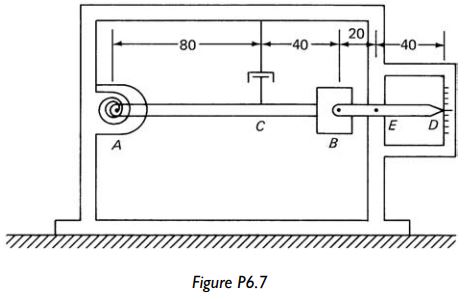Question 6.P.7: A seismic instrument designed to measure vertical accelerati...
A seismic instrument designed to measure vertical acceleration consists of a light beam AB pivoted at A through a torsional spring of constant 20Nm (Fig. P6.7). A small body of mass 0.6 kg is fixed to the beam at end B and a viscous damper is attached at C. The pointer BED, pivoted to the 0.6 kg mass at B and to the instrument casing at E, moves over the scale at D as shown in the figure. The viscous damper is adjusted to provide a damping of 0.7 times the critical. Obtain the undamped natural frequency of the instrument and the damping coefficient of the viscous damper. The instrument is calibrated to read the support acceleration correctly at an input frequency of 1 Hz. Obtain the calibration factor. If the support acceleration is 3 m/s² at a frequency of 5 Hz what will be the instrument reading and what is the percentage error?

Learn more on how we answer questions.
ω = 48.11 rad/s, c = 90.94 N ·s/m. Calibration factor of 1157.2 will convert reading in mm to acceleration in mm/s². Error at 5 Hz: 7.4%.